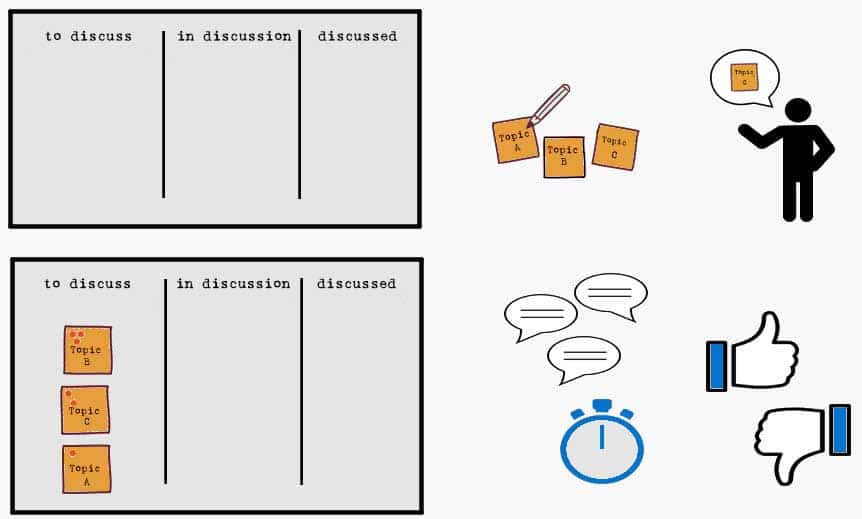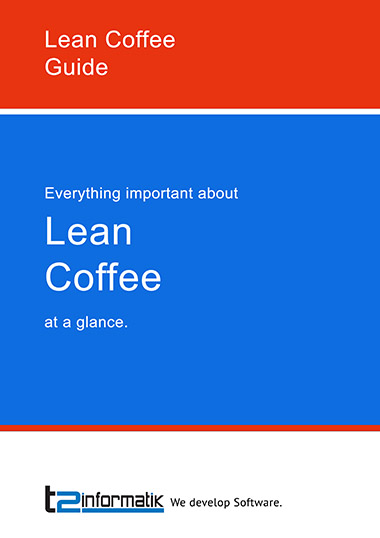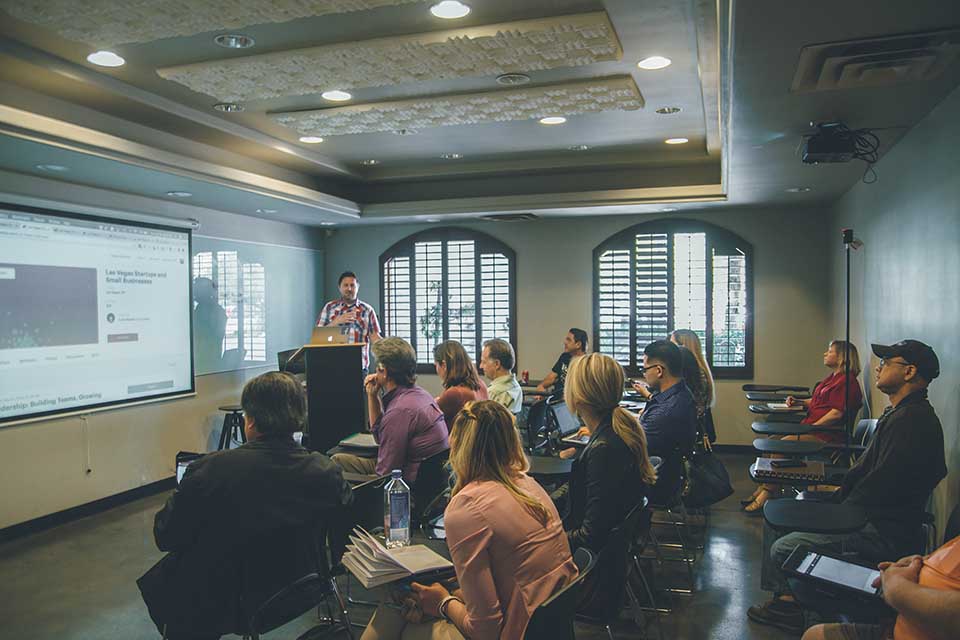What is Lean Coffee?
Smartpedia: Lean Coffee is a format for a meeting, with no pre-defined agenda, no obligation to participate and no pre-defined objectives.
Lean Coffee – an agendaless meeting for exchange at eye level
Often, meetings are considered time-consuming, unproductive, and inappropriate. A lack of objectives, participants with different interests, a missing agenda – a list of points of criticism is easy to create. Lean Coffee does not try to eliminate these mistakes, but makes a virtue out of them. Lean Coffee is a format for a meeting, without a pre-defined agenda, without an obligation to participate and without a pre-defined objective. It is a structured format for unstructured meetings.
The first public Lean Coffee was conducted by Jeremy Lightsmith and Jim Bensen, two American Agile Coaches, 2009 in Seattle, USA. The name goes back to the principles of Lean Thinking – with individual learning, personal responsibility and knowledge exchange – in a desirable coffee shop atmosphere.
How does Lean Coffee work?
Even though the Lean Coffee method is in itself an unstructured format for exchange at eye level, there are some points that contribute to successful interaction:
- An invitation is published – e.g. on the bulletin board, by e-mail, on the intranet, etc. – with place, date, time, duration (usually between 1 and 2 hours) of the meeting and ideally a set of topics so that potential participants can assess whether they are interested in an exchange.
- Before the meeting begins, a flip chart or whiteboard with a table consisting of three columns is prepared: “to discuss”, “in discussion” and “discussed”. Alternatively, the columns can also be called “ready”, “in progress” and “done”.
- A participant of the group takes over the coordination or moderation during the meeting.
- Topics and questions are collected. Each participant notes his or her personal questions on moderation cards or post-its. All questions are arranged in the column “to discuss” and are visible to all participants. There is no limit to the number of questions per participant. Ideally, each question poser is given the opportunity to briefly explain the background of the question and thus make a little advertisement for the respective topic.
- The topics are prioritized. Each participant gives 2 (sometimes also 3 or 5) points, whereby all points may also be used for a single (and own) topic.
- The topics are sorted according to the number of points. The topic with the most points is discussed first.
- The group determines a timebox, i.e. the duration of one discussion per topic. It often depends on the number of topics. Since as many topics as possible are to be discussed, time windows of 5 or 10 minutes are often agreed upon.
- The discussion on the first topic begins. The coordinator pushes the first moderation card into the column “in discussion”. The question poser explains the background of his topic and, if necessary, a desired result. The discussion begins.
- The coordinator ensures that the timebox is adhered to. When the agreed time has expired, he asks the participants whether the topic should be discussed further or whether it has been finally discussed. The vote can be done simply by hand signal or by “thumbs up” or “thumbs down”.
- It should be clarified in advance whether there should be a majority decision or a veto decision. In the case of a veto decision, a vote for the end of the discussion is sufficient to end the discussion during the meeting.
- If there is an extension, depending on the agreement, a new time box begins with a) identical duration or b) shortened duration (e.g. half of the original time box).
- Even after a possible second round, a query follows; if the vote provides for a further extension, the topic should be discussed in a separate meeting. In order to be able to discuss further topics during the meeting, the moderation card is moved to “discussed” or alternatively to a separate column “separate meeting”.
- The moderator moves the second moderation card to the “in discussion” column and it starts.
Often not all topics are discussed within a Lean Coffee. It is the responsibility of each participant to discuss topics that have not been discussed at the next meeting.
What are the challenges with the Lean Coffee method?
One challenge with the Lean Coffee method is that it requires careful facilitation to be effective. The facilitator must be able to manage the flow of discussion and ensure that all participants are given the opportunity to contribute.
Another challenge is that the method requires participants to be able to organise and prioritise their ideas and thoughts effectively. This can be difficult for some people, especially if they are not used to this type of discussion.
In addition, the Lean Coffee method can be challenging for people who are not familiar with agile methods or are not comfortable with agenda-less sharing. It can take some time for participants to get used to the format and feel comfortable contributing their ideas.
Overall, Lean Coffee can be an effective approach to facilitating discussions and making progress on important issues, with careful facilitation and the ability of participants to prioritise and organise their thoughts effectively being important success factors.
Tips for applying the Lean Coffee method
Here are some tips for running a Lean Coffee:
- Encourage all participants ahead of time to bring possible discussion topics.
- Use a simple voting system, such as point voting, to prioritise the topics and determine the order in which they will be discussed.
- Encourage active participation and ensure that everyone has an equal opportunity to contribute their thoughts and ideas. Encourage open and honest communication and avoid personal attacks.
- Actively invite a change of perspective so that views, experiences, opinions, interpretations of others can be heard, understood and ideally also used to make better decisions, identify useful ideas or solve problems.
- Combine the method with other approaches such as 1-2-4-All or Reverse Brainstorming.
- Take detailed notes and record any action points that arise from the discussions.
In principle, it is certainly also useful to evaluate the format as such again and again in order to determine what works well and what can be improved.
Advantages of Lean Coffee
The big advantages of Lean Coffee are
- in the simplicity of the format,
- the low organisational effort for preparation and implementation,
- the discussion at eye level and without hierarchies,
- the brevity of the format,
- and the regularity of the exchange.
A good moderator, consistent visualisation and adherence to the agreed timebox are important for success. The larger the group, the more difficult it becomes to use the format; a similar problem occurs in walk and talk meetings. And it’s probably not a good idea to organise a Lean Coffee stand-up meeting due to the time it takes.
Lean Coffee Software
There are some tools that offer support for Lean Coffee meetings. Here you will find a small list without any claim to completeness and without evaluation:
The list can certainly be extended, especially since there are numerous products that are used in organisations of meetings but originally have a different marketing focus.
The format is also possible remotely or online. In your view, does this mean that the personal, individual touch is lost or do the advantages of being able to discuss topics with people regardless of location outweigh the disadvantages?
Notes:
If you like the article or would like to discuss it, please feel free to share it in your network. And if you have any comments, please do not hesitate to send us a message.
Here you can find a tool to conduct Lean Coffee online.
Here you can find a video that explains Lean Coffee in 5 minutes.
And here you will find additional information from our Smartpedia section:




